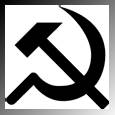 |
PINSK
FALLS UNDER SOVIET OCCUPATION IN 1939 |
 |
| NAZI
GERMANY |
September
1939 Location of Piñsk where we lived, can be seen on the map in the middle of right hand side of Poland |
COMMUNIST RUSSIA
|
 |
1939
- SOVIET OCCUPATION OF EASTERN POLAND |
Red
Army crosses the
Polish border on the 17th September 1939, after destroying
the border marker. Soon afterwards all boundary markers
were removed. |
Two weeks after Germany attacked Poland, over a million of Soviet troops invaded Poland from the east on 17th September 1939. The Red Army entered Piñsk
on Wednesday 20 September 1939, three days after crossing Polish
border. Presumably "the Pripet Marshes" were not easy to cross. |
Red Army marches into Polish border village on 17 September 1939 |
|
Two pleased Red Army soldiers |
|
|
|
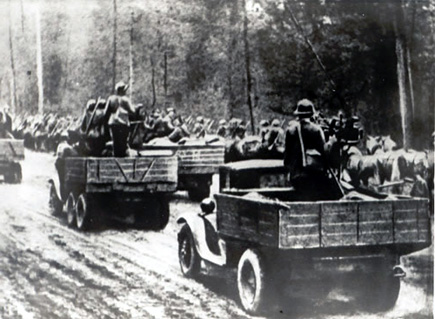
More Red Army troops advancing over Polish territory - September 1939 |
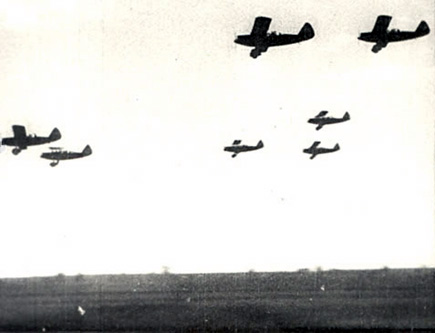
Soviet planes over Eastern Poland dropping above leaflets , in some places dropping bombs - 17 September 1939 |
Destruction of former Polish border markers and fortifications by Red Army soldiers - September 1939 |
Destruction of former Polish border markers and fortifications by Red Army soldiers - September 1939 |
Red Army troops and a German observer marking and setting up a new border between Soviet Russia and Nazi Germany on the former Polish territory |
After entering Piñsk on 20th September 1939, they destroyed the Jesuits Catholic Church with close range heavy artillery fire, using an excuse that there were some snipers shooting from church spires. Few days later they set fire to the Russian Orthodox cathedral. They decided to keep the Jewish synagogue, explaining that its structure would be suitable for public baths (banya). As soon as Russian troops occupied Pinsk, the NKVD (KGB) started arresting people. First, some important officials and notables were arrested and executed in prison yard during the first few days. Then all military personnel were imprisoned and removed to camps in the USSR. At that time there were many soldiers in Pinsk who retreated eastwards from the war front. Also all sailors of the River Flotilla stationed in Pinsk were arrested. All Police officers were targeted and arrested. In fact anybody who wore some kind of a uniform was arrested, even some boy scouts got caught. All these prisoners were regarded as "prisoners of war" - POWs (including army chaplains) and were taken to various POW camps in Russia. In Pinsk we had a Jesuit Seminary and a lot of clerics, so lots of priests were also arrested. During the 21 months of occupation of Eastern Poland (until June 1941 when Hitler attacked the Soviet Union) the Russians systematically continued to arrest civilians, usually in the middle of the night. They were government public servants as well as local administration, high school lecturers as well as primary school teachers, lawyers, merchants, manufacturers, landowners as well as "kulaks" (well-off peasants), social and political activists, etc. These were locked up in prisons for interrogations of false accusations, fake trials, and sentencing. Due to lack of prison space in Pinsk, also former Polish military barracks in the town were turned into prison. Due to overflow even in
the army barracks, a lot of prisoners had to be transferred to a large
Soviet prison in Minsk. The interrogations lasted for many months, due
to the fact that victims could not agree and resisted false and stupid
accusations until they were broken physically and mentally. They were
accused of being saboteurs, spies, exploiters of the working class,
counterrevolutionaries (i.e. members of non socialist organizations,
even dating back to 1919-20 Polish-Bolshevik war !), and also those
that were recently crossing (either way) the new Soviet-German border,
etc. Sentences were severe and the victims were sent to various gulags.
Half of them have not survived the first two years. At the same time,
the families of all arrested men (i.e. women, children and old people),
were removed in four mass deportations to hard labour in various remote
parts of the Soviet Union in Northern Russia and Siberia. Total number
of victims, about 2 million people. |
COMPULSORY
SOVIET CITIZENSHIP TO ALL |
|
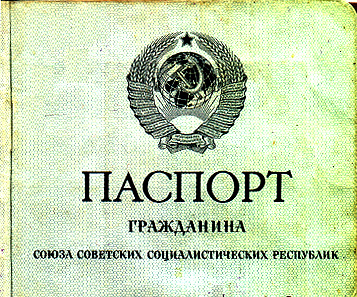 |
|
In Siberia my passport was taken away and a new one issued numbered AK - No. 720 937, with annotation "spetz-peresielenetz", meaning "special deportee-convict". Letters AK meaning Akmoliñsk, capital of the province, now called Tselinograd. |
It is the same small size as original with white corner intended for impression of the segment of a round stamp. |
Description
on the stamp says "Osvobozhdenye" with a date 17.IX.1939,
meaning "the liberation" on 17th September 1939.
|
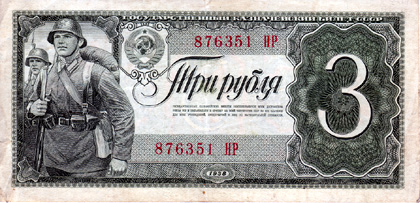 Soviet 3-rouble banknote, issued in 1938 (still in my possession) |
CESSATION
OF POLISH SCHOOLING |
1939 - POLISH STATE COLLEGE FOR BOYS and separate nearby FOR GIRLS IN PINSK (GIMNAZJUM MESKIE i ZENSKIE PANSTWOWE). The College was changed to BELORUSSIAN SECONDARY SCHOOL No.1 (and boys and girls were put together). |
The students had a choice by open-voting (raising of hands) of making our College a Russian School or a Belarus School - NOT a Polish School. Majority of students were Poles, all patriotic, and they voted for a Belorussian College mainly to demonstrate opposition to Russian rule. Only the Jewish students, being more practical and some sympathising with Russian communism, voted for a Russian School but they were in the minority and lost.
|
|
||
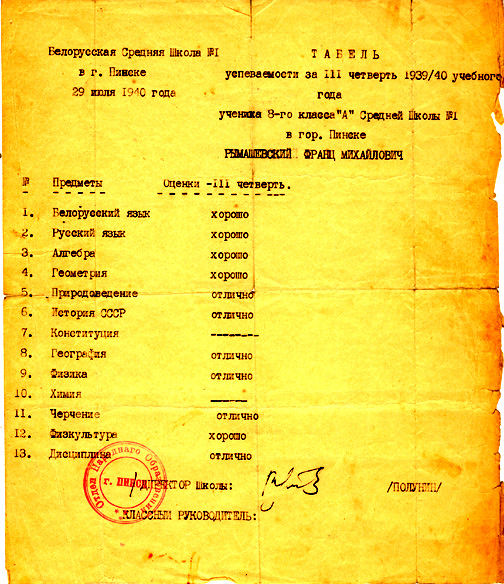 |
|
|
DEPORTATIONS
TO FORCED-LABOUR CAMPS IN REMOTE AREAS OF THE USSR |
|
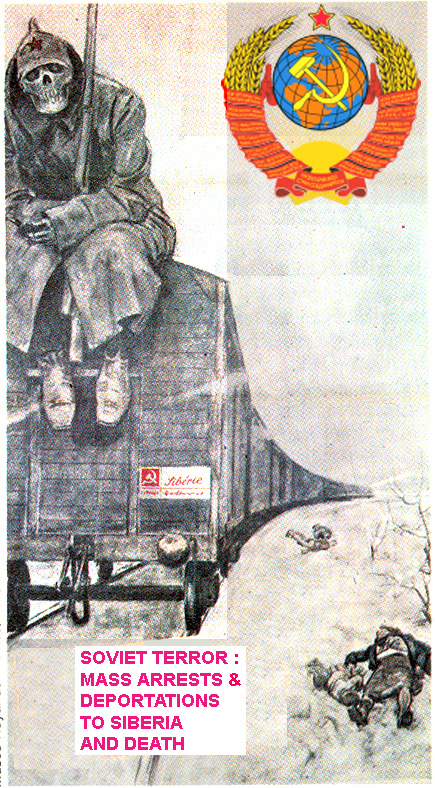 |
|
These were the type of cattle wagons in which the Poles were deported to forced-labour camps throughout the USSR |
THE SOVIET
STORY |
THE
FATE OF RYMASZEWSKI FAMILY FROM PINSK |
66.12
|
Michal RYMASZEWSKI | DIED |
|
| Our historical family documents dating 17th-18th century, indicating our former noble status, were removed by the KGB during the search of our house as incriminating material and were taken with my father to Miñsk prison. Also all photographs from our albums showing people in any kind of uniform were taken, not necessarily military, e.g. a postman, a railway employee, etc. — according to communist mentality, uniform made people suspect as ideological enemies. All these documents, if not destroyed during the war, could still be in Belarus in KGB's Minsk archives. |
|
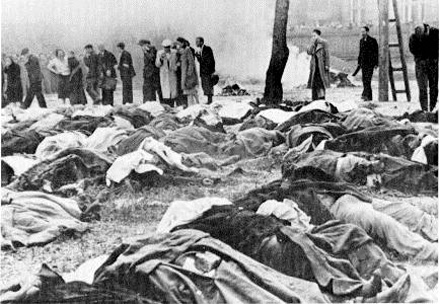 JULY 1941 - TOWN INHABITANTS TAKING CARE OF MURDERED BY RUSSIANS BODIES OF POLES IN THE LWÓW PRISON YARD AFTER THEY LEFT BEFORE ADVANCING GERMANS |
Path
of death : Minsk - Cherven |
|
Location of town Cherven, east of MINSK where almost certain my father was murdered by the Soviets |
66.121 66.122 |
Edward
RYMASZEWSKI Zygmunt Tadeusz RYMASZEWSKI |
|
66.123 66.124 66.12 w |
Franciszek
Romuald RYMASZEWSKI Zbigniew Stanislaw RYMASZEWSKI Aleksandra RYMASZEWSKA |
|
This was done by their deportation to remote areas of the USSR, subjecting them to the exposure to severe climates, primitive living conditions, hard physical work, continuous hunger and starvation, and disease.
|
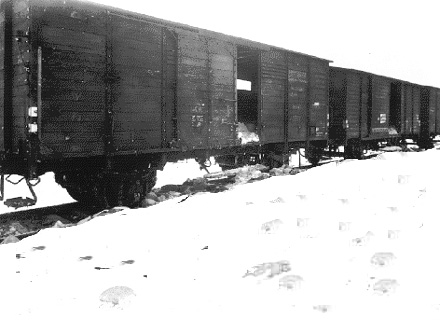 UNHEATED CATTLE TRUCKS BROUGHT TO THE RAILWAY SIDING IN PINSK READY FOR THE DEPORTEES |
| On
13 April 1940 at the age of 16, I was arrested by the NKVD
(KGB) in the night, near the very early morning, together with my younger
brother Zbyszek, age 13, and my mother, age 45.
Then we were escorted to the railway sidings at the freight area of
the station and locked up in one of the trucks, ready for deportation.
We were destined to forced hard labour on starvation diet in
Northern Kazakhstan, Western Siberia. Approximate location is
marked with X. The travel took nearly three weeks. We were all crammed into the unheated cattle trucks, 40 people per truck. Mostly women, wives of imprisoned men, and their children and a few elder relatives, together with some permitted personal possessions. We were packed like sardines and locked up for the duration of journey. Some people sat on raised platforms of rough boards each end of truck, unlucky ones were squatting on the floor underneath platforms. Near the middle of the truck there was a hole in the floor which served as a toilet without any privacy except for a bit of a ragged curtain. The train was around 40 trucks long with two big steam engines, one pulling in front and the other one pushing at the back of the train. The slow dragging journey lasted 2 weeks and 3 days. From Pinsk we passed Luniniec to Mikaszewicze, the former border town between Poland and USSR. We had to change there to another similar train because Soviet rail tracks were wider than European. Then we went through Gomel, where my mother started to cry, calling out Anna, her mother, who was trapped in Soviet Russia since the Bolshevik Revolution and was buried there in Gomel. We continued to Konotop, Kursk, Voronezh, Tambov, Penza, Michurinsk and Kazan. |
|
| At a stop in Kazan a local starving population, mostly of Tatar nationality, with outstreched hands were begging bread from us, the convict - deportees. Some of us were throwing their bread to the" free people of the Soviet paradise". Usually our stops were not on railway stations but on the sidings nearby, and mostly at night. On the way we've passed similar transports of deportees from other Polish towns, heading east. Our engines were changed before climbing the Ural mountains. Then we went past the Ural mountains to Sverdlovsk, Chelyabinsk, Petropavlovsk and finally Kokchetav, where we were unloaded some distance from the town and sat on the ground alongside the rail track. Sweating in the overcrowded by humans cattle truck, then chilled by draughts while passing through the cold, snow covered Ural mountains, I developed pneumonia with needle pains and fever. There was no medical attention of any kind. |
Passing
European Russia Smokey- steaming train passing Ural Mountains and Sverdlovsk to Asian part |
Soviet locomotive powerful for long distances over tracks covered with snow
|
|
|
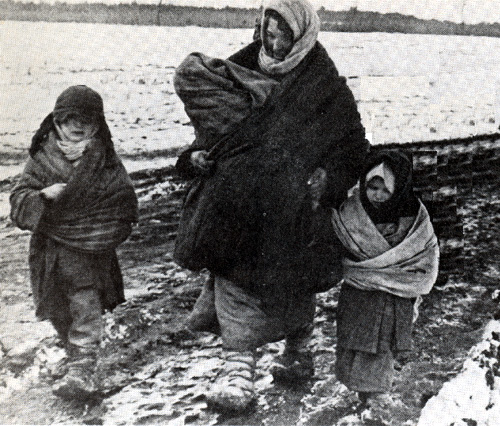 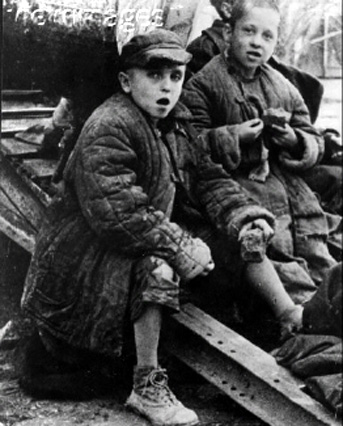 |
||
Things got worse with time and after the outbreak of the 1941 German - Soviet war. My gums were bleeding and teeth were becoming loose from scurvy. My legs and neck were covered with large scabs (ulcers) resulting from semi-starvation. My worn out shoes were falling off, and my clothes were ragged and torn, and full of lice. My younger brother Zbyszek and mother suffered hunger, frost, hard work and all hardships, as all of us. |
 Abandoned these days and forgotten Polish graves in Siberia, many with missing crosses. |
|
THE
FATE OF RELATIVES FROM ZASCIANEK |
|
| 66.11 66.14 |
Bronislawa
RYMASZEWSKA Jadwiga RYMASZEWSKA |
|
|
67.11
|
Czeslaw RYMASZEWSKI | DIED |
|
67.11
w 67.113 67.1 |
Emilia
RYMASZEWSKA (wife) Romuald RYMASZEWSKI Boleslaw RYMASZEWSKI (1876 ? - 1944) |
|
67.111 67.112 |
Witold
RYMASZEWSKI Mieczyslaw Arnold RYMASZEWSKI |
April
1940 Polish deaths at Soviet hands. THE KATYN FOREST MASSACRE |
|
|
|

Notes in year 2000 about Katyn |
| Apart from the Katyn genocide in April 1940, thousands of Polish civilians were also killed in various Soviet prisons in Eastern Poland during the first occupation between 1939 and 1941. My father Michal Rymaszewski (66.13) born in 1894 and my uncle Czeslaw Rymaszewski (67.11) born in 1897 were murdered by the NKVD while in prison. After the war there was never a Nuremberg-style trial, or ANY trial, for the crimes and atrocities committed against humanity by the Soviet Communist Leaders. |
|
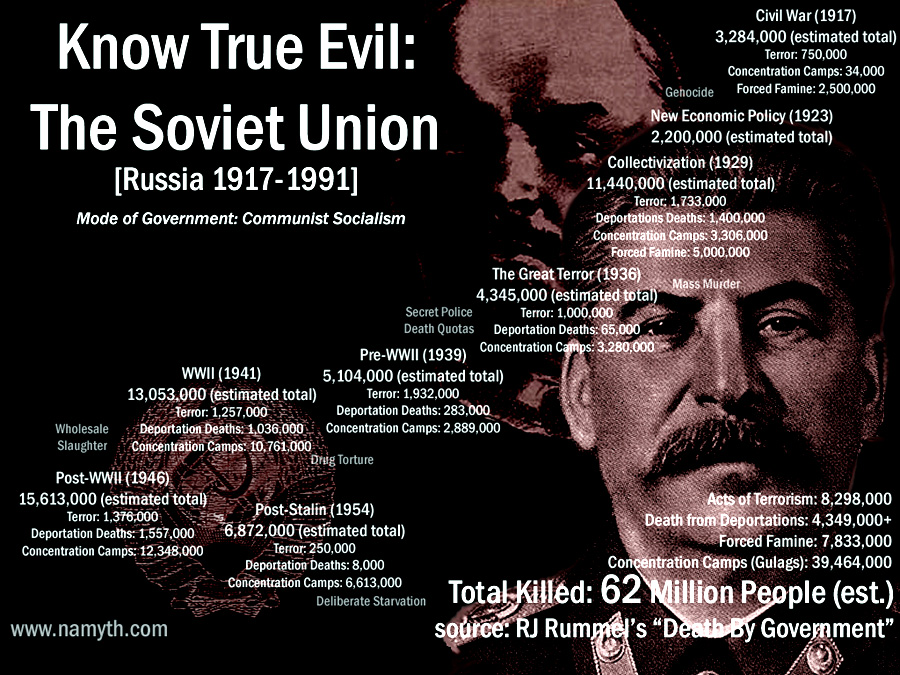
| 1: INTRODUCTION by Franek Rymaszewski | 7: WITH MY BROTHER in WARTIME ENGLAND | 11: POLISH CHRISTMAS and EASTER | ||
| 2: MY FAMILY TREE | 8: MY FAMILY SURVIVORS in POLAND | 12: ANCESTORS - Part 1 : Origin and Records | ||
| 3: RELEVANT MAPS and POLISH HISTORY | 9: MY EMIGRATION to AUSTRALIA | ANCESTORS - Part 2 : Family Tree | ||
| 4: MY FAMILY ANCESTRY in POLAND | 13: Rymaszewskis in present-day POLAND | |||
| 5: PINSK UNDER COMMUNIST TYRANNY | 10: Descendants in AUSTRALIA - Part 1 | 14: Rymaszewskis WORLD-WIDE (Part 1) | ||
| MIETEK'S MEMOIRS OF GULAG | Descendants in AUSTRALIA - Part 2 | Rymaszewskis in the USA (Part 2) | ||
| 6: MY ESCAPE FROM STALIN | Descendants in AUSTRALIA - Part 3 | 15: EMAILS from Visitors |

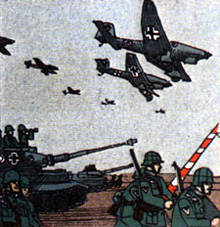
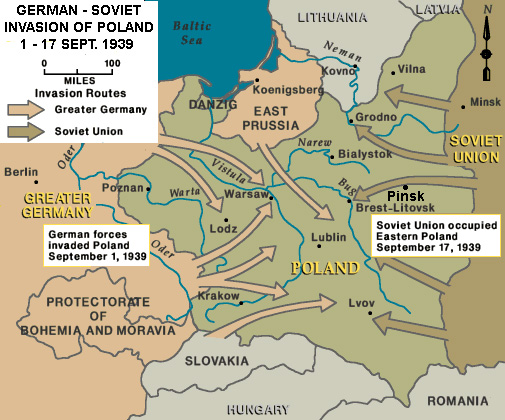
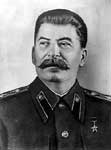
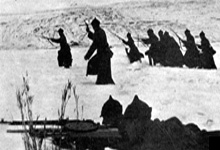
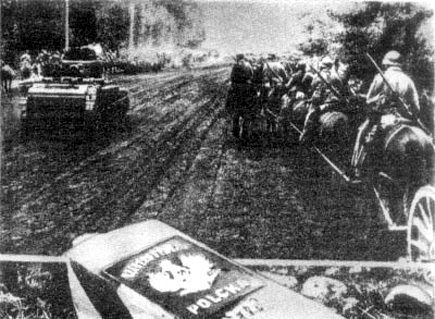
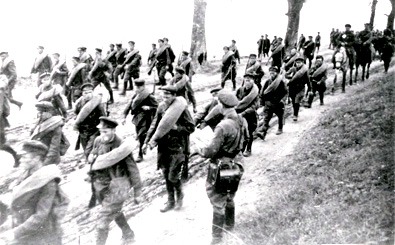
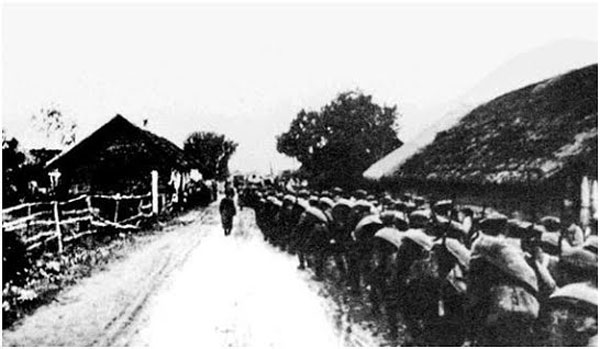
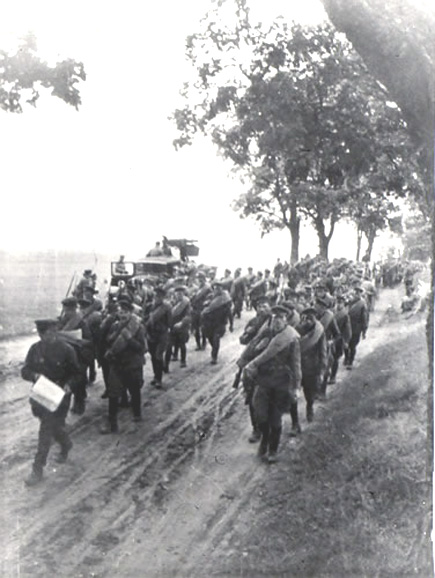
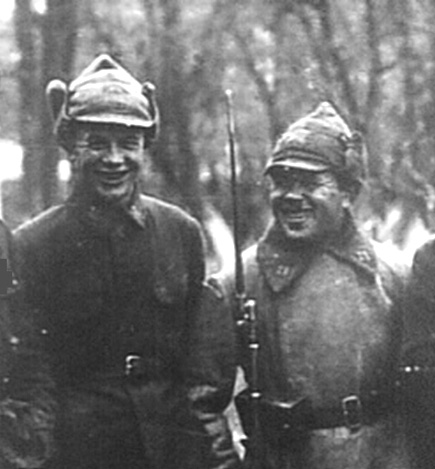
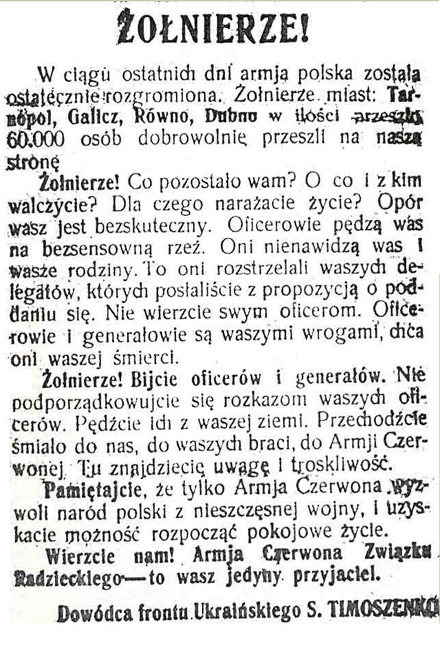
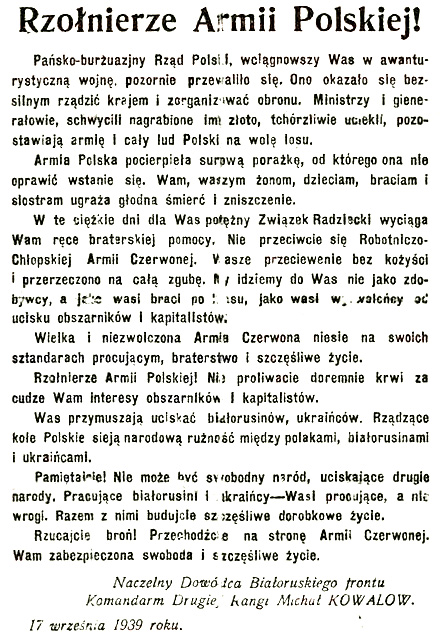
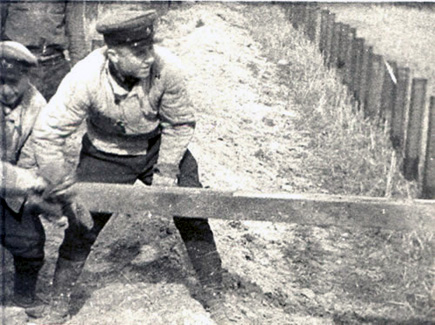
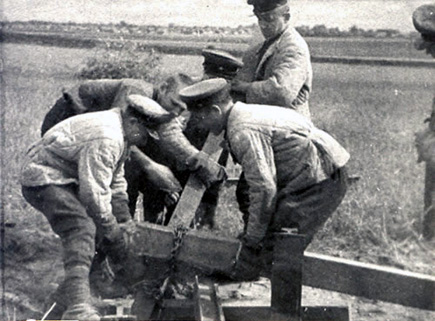
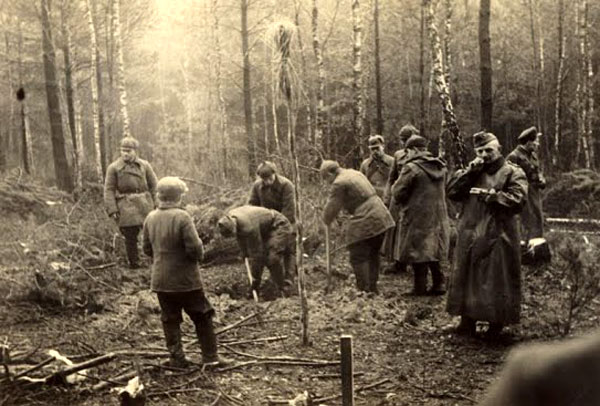
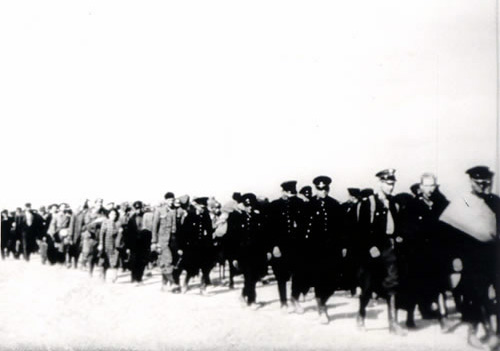
 My
spare photo, age
16,
taken in Pinsk for the soviet
passport, soon before
my deportation.
My
spare photo, age
16,
taken in Pinsk for the soviet
passport, soon before
my deportation. 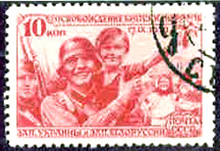
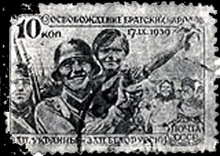
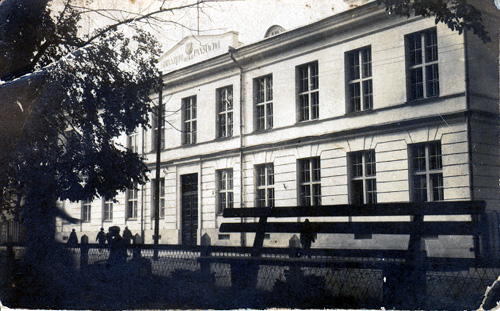

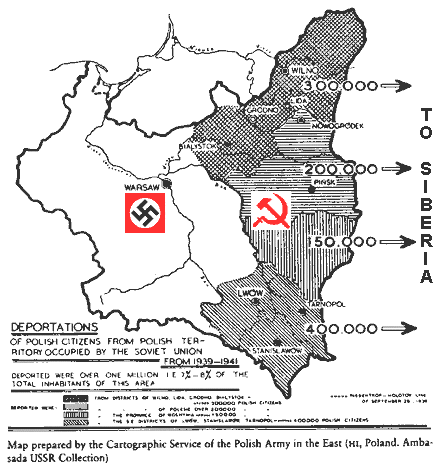
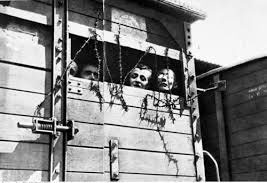

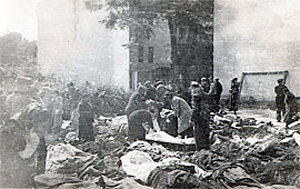
 most
of those who had served terms for real criminal offences, were separated
from the crowd and were moved further east.
most
of those who had served terms for real criminal offences, were separated
from the crowd and were moved further east. 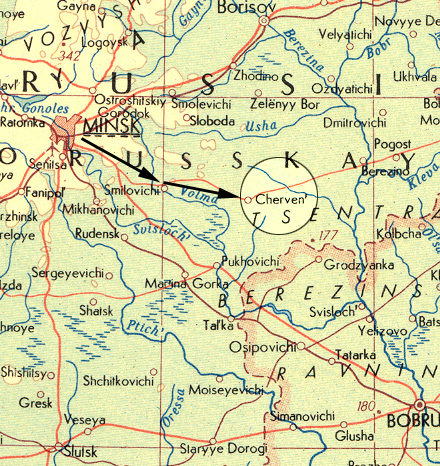
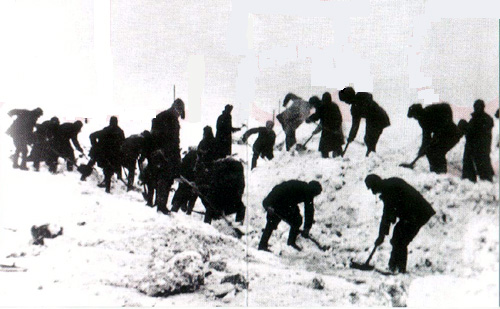 However,
he was caught by the Russians, crossing the border in the heavy snow
near Bialystok, and for this crime was sentenced
to 10 years hard labour. It must be said that Germany and Russia
were at that time great friends and allies. Nevertheless Edward
was sent to one of the Vorkuta gulags in the North, near the
Arctic Circle (see image >>).
However,
he was caught by the Russians, crossing the border in the heavy snow
near Bialystok, and for this crime was sentenced
to 10 years hard labour. It must be said that Germany and Russia
were at that time great friends and allies. Nevertheless Edward
was sent to one of the Vorkuta gulags in the North, near the
Arctic Circle (see image >>).
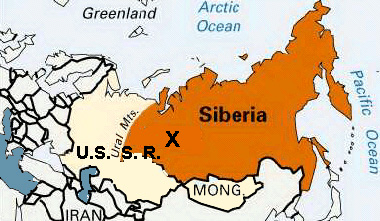
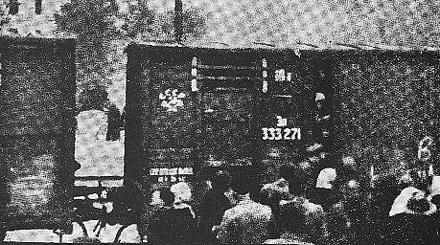
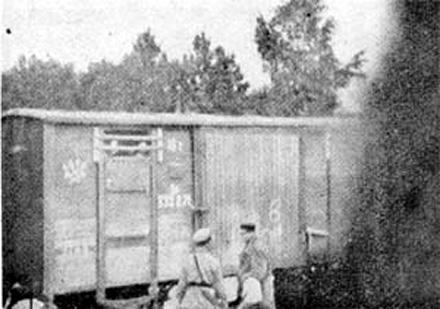
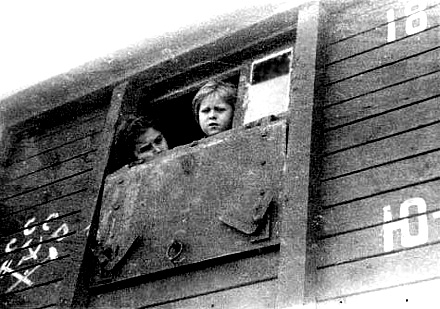



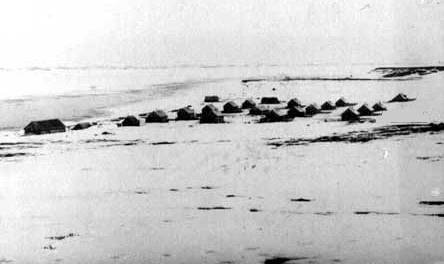 From
Kokchetav the Polish women and their children were taken in lorries
and scattered throughout 300 km area to various remote villages and
"kolhoz'es" (collective farms). My mother, my younger brother
and myself, with pain in the chest and a fever, were taken by open
lorry 100 km away from the railway line to a district village Aryk
- Balyk.
From
Kokchetav the Polish women and their children were taken in lorries
and scattered throughout 300 km area to various remote villages and
"kolhoz'es" (collective farms). My mother, my younger brother
and myself, with pain in the chest and a fever, were taken by open
lorry 100 km away from the railway line to a district village Aryk
- Balyk. 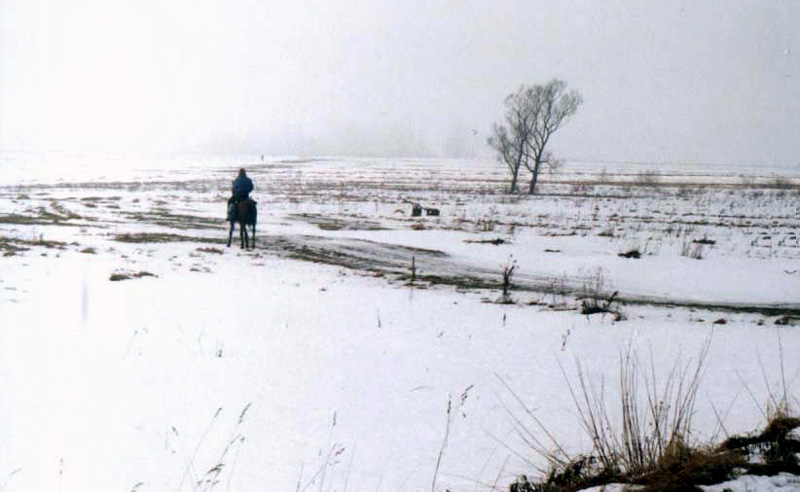
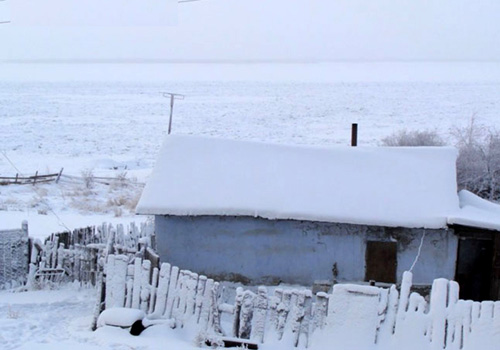 In
Korsakovka 8 Polish women with 6 children were dropped off. I
had no treatment for my pneumonia. After five weeks (and
some help from the locals - rubbing my chest with killed dog's fat
- there was no other fat available) my young body recovered, but I
was frequently coughing for the whole year. We had to work hard and
sleep in the fields, 6 to 12 km away from the village, surrounded
by vast empty steppes. The first year there were bad crops and militiamen
were forcibly taking away from the Russian peasants whatever little
stored grain they owned, in order to fulfill the compulsory State
quota of "tax in kind" imposed on the kolhoz. The collective
in those parts of Siberia could produce only wheat and hay. Members
of the collective worked the whole year without pay. In the autumn
the crops were delivered to government silos as tax and what was left,
was divided among the kolhozniks in proportion to the amount of their
"workdays". Then few crates of Russsian vodka was delivered
to the kolhoz at nominal price, so that the slaves could get drunk,
forget about last year and start again. That was the true Soviet socialist
"workers' paradise" - not the lies portrayed by the Soviet
financed socialist propaganda in the West.
In
Korsakovka 8 Polish women with 6 children were dropped off. I
had no treatment for my pneumonia. After five weeks (and
some help from the locals - rubbing my chest with killed dog's fat
- there was no other fat available) my young body recovered, but I
was frequently coughing for the whole year. We had to work hard and
sleep in the fields, 6 to 12 km away from the village, surrounded
by vast empty steppes. The first year there were bad crops and militiamen
were forcibly taking away from the Russian peasants whatever little
stored grain they owned, in order to fulfill the compulsory State
quota of "tax in kind" imposed on the kolhoz. The collective
in those parts of Siberia could produce only wheat and hay. Members
of the collective worked the whole year without pay. In the autumn
the crops were delivered to government silos as tax and what was left,
was divided among the kolhozniks in proportion to the amount of their
"workdays". Then few crates of Russsian vodka was delivered
to the kolhoz at nominal price, so that the slaves could get drunk,
forget about last year and start again. That was the true Soviet socialist
"workers' paradise" - not the lies portrayed by the Soviet
financed socialist propaganda in the West.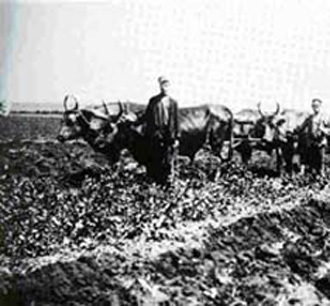 Because
of our convict-deportee status we had no right to join the kolhoz.
This meant that we were treated similarly to very rare independent
farm workers in USSR, called "yedinolichniks". Of course
we had to work, but according to rule (at least theoretically),
we had "to pay high bazaar prices for food", i.e. for the
piece of bread and flour dumplings soup while at work. After one year
of hard labour I found out that I did not earn anything. Neither did
my mother or brother. When in the autumn after the harvest I
asked for some wheat grain for my work, I was told, with laughter,
that I was actually owing the kolhoz because "ty vsio prokushal
" (you have eaten all what you've earned).
Because
of our convict-deportee status we had no right to join the kolhoz.
This meant that we were treated similarly to very rare independent
farm workers in USSR, called "yedinolichniks". Of course
we had to work, but according to rule (at least theoretically),
we had "to pay high bazaar prices for food", i.e. for the
piece of bread and flour dumplings soup while at work. After one year
of hard labour I found out that I did not earn anything. Neither did
my mother or brother. When in the autumn after the harvest I
asked for some wheat grain for my work, I was told, with laughter,
that I was actually owing the kolhoz because "ty vsio prokushal
" (you have eaten all what you've earned).  In
Matveyevka there were 13 Polish deported women and 14 children also
living in squalor and deprivation. During the first 21 months before
I left them to go to the Army, three Polish women and five Polish
children died from starvation and hard work in Matveyevka alone
. Similar story happened to all deported Polish women, and especially
children, in every kolhoz in Kazakhstan.
In
Matveyevka there were 13 Polish deported women and 14 children also
living in squalor and deprivation. During the first 21 months before
I left them to go to the Army, three Polish women and five Polish
children died from starvation and hard work in Matveyevka alone
. Similar story happened to all deported Polish women, and especially
children, in every kolhoz in Kazakhstan.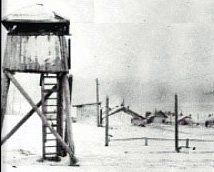 20
years old Witold was arrested in Malkowicze by
the NKVD and sent to hard labour in one of the gulags inside
the USSR. He survived the gulag and the war, and now lives in Poland.
See "more".
20
years old Witold was arrested in Malkowicze by
the NKVD and sent to hard labour in one of the gulags inside
the USSR. He survived the gulag and the war, and now lives in Poland.
See "more".
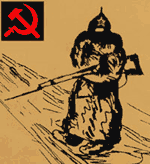
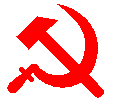
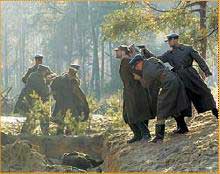
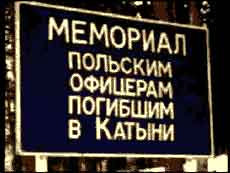
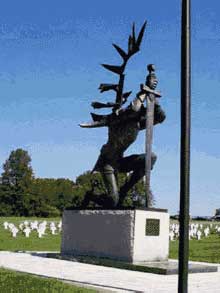 Sculpture
- memorial in Katyn:
Sculpture
- memorial in Katyn:  THE
HAMMER AND SICKLE IS A HATE SYMBOL.
THE
HAMMER AND SICKLE IS A HATE SYMBOL.
